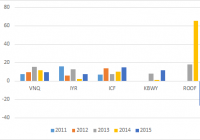Commercial Real Estate May Help Provide A Smoother Ride On The Road To Your Investment Goals
By Jennifer Perkins, Portfolio Manager, Principal Real Estate Investors Much hasn’t changed since the start of the year! Financial markets have recovered somewhat, but are still volatile due to geopolitical concerns, and declining oil and commodity prices have also impacted stock prices and economic growth. Meanwhile, the chase for yield in a low interest environment still continues in fixed-income markets. With an eye on the road ahead, investors are hoping for a smoother and less stressful ride to meet their investment goals. The vehicle that could get them there is commercial real estate! This is the second in a series of four blog posts highlighting some compelling reasons why we believe many investors should include private – also referred to as direct-owned – commercial real estate in their investment portfolios. While these reasons are not new, market volatility, changing market dynamics, and the potential of lower long-term return expectations raise an opportunity to reiterate the case for considering the asset class for inclusion into your portfolio. Compelling reasons to include private commercial real estate: Adds portfolio diversification. May aid in dampening volatility, potentially increasing portfolio total risk-adjusted return. A source of potential income. A possible defense against unexpected inflation. Just to recap, my last blog post discussed why private commercial real estate hasn’t historically conformed to similar whipsaw behavior the equity market was experiencing at the start of 2016, potentially allowing for private commercial real estate to add true diversification to an investment portfolio. This blog post expands upon Reason 2: Private commercial real estate may aid in dampening volatility and increases the potential for improving total portfolio returns adjusted for risk. As an investor in private commercial real estate, you are buying units of ownership of office buildings, industrial buildings, apartment buildings, retail centers, and even hotels. The buildings comprising a larger portfolio are acquired through private transactions between a willing buyer and seller, specific to individual properties. Investing in tangible properties influenced by space market fundamentals (meaning tenant demand and available supply) versus investor sentiment likely helps to dampen volatility. Unlike Real Estate Investment Trusts (REITs), private commercial real estate is not influenced by fractional ownership trading, which occurs in public markets on a public exchange. Values of private commercial real estate are also supported by in-place contractual leases, typically having meaningful duration, that help drive a steady and fairly predictable stream of income for investors of core, occupied commercial real estate. Investor return requirements on this current income, as well as total holding period returns, are driven by spreads over risk-free rates (Treasurys). Such tenant demand, available supply, contractual lease terms, and investor return requirements don’t dramatically change each and every day, thereby helping to create the potential for a return pattern with lower volatility or variability over an investment period. Over the past 10 years, the ride or return pattern experienced when investing in stocks, bonds, and private commercial real estate has been notably different (see Exhibit A). The return pattern for commercial real estate has been far smoother compared to stocks and bonds. By including an allocation to commercial real estate in an investment portfolio, the ride over the investment period could be smoother, with less turbulence. Click to enlarge Indexed to 100 as of 31st March, 2016; Source: 500 Data (Bloomberg), Investment Grade Corps (Barclays), CRE Private Equity (NFI-ODCE EW); It is not possible to invest directly in an index. Past performance does not guarantee future results. A smoother expected ride also creates the potential for increased total portfolio returns when adjusted for risk. Private commercial real estate could offer a strong income (current) return (historically 70-80% of total return) as well as the potential for appreciation (or depreciation). Exhibit B shows the effects of increased exposure to private commercial real estate has produced a slight increase to total portfolio returns, but most notably, lowered the risk, or volatility, of those returns over the 10-year time period. Therefore, the inclusion of private commercial real estate within an investment portfolio has the potential to increase total portfolio return per unit of risk. Click to enlarge Click to enlarge Click to enlarge Source: S&P 500 Data (Bloomberg), Investment Grade Corps (Barclays), CRE Private Equity (NFI-ODCE EW) In my next blog post, I will discuss Reason 3: Private Commercial Real Estate is a potential source of durable income ; another compelling reason to consider including commercial real estate as part of an investment portfolio. Stay tuned and enjoy the ride! — 1 Percentage of risk shown is the annualized standard deviation of index returns and is a measure of return volatility. 2 Annualized holding period total returns divided by standard deviation of returns over equivalent period. It is not possible to invest directly in an index. Past index performance is not indicative of future return.
